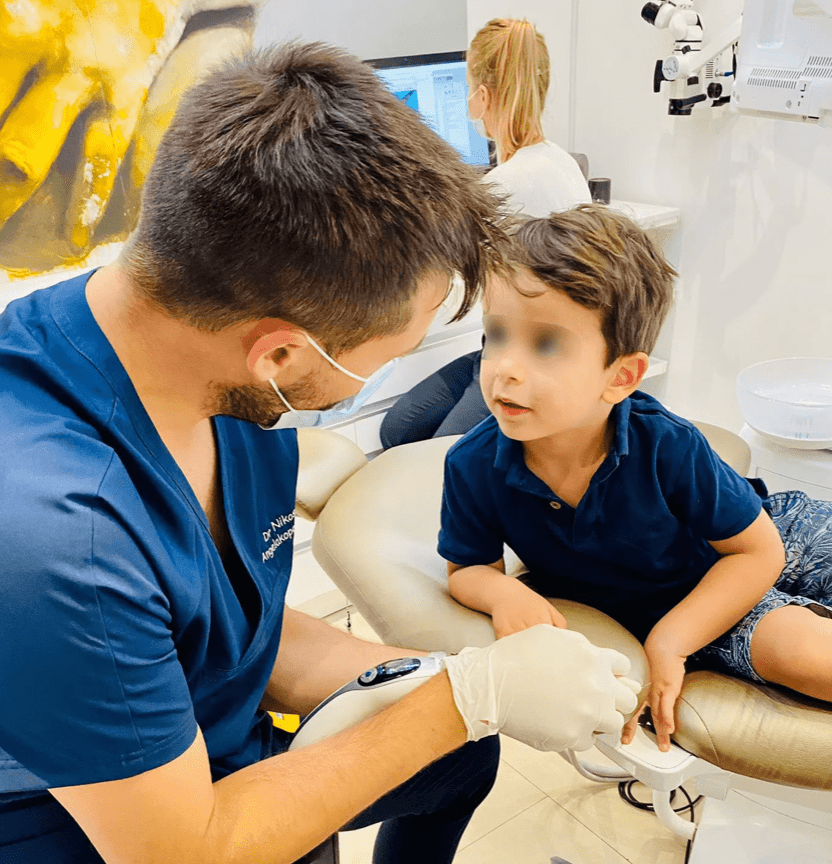Brushing children's teeth

We’ve all learned a lot about staying healthy lately. As parents, you give good advice about avoiding germs in public places, cleaning things we touch often, like phones and keyboards, and learning the best way to wash our hands. These small daily habits can have a big impact on your child’s health. And since you’re already taking care of your little one by making sure she brushes her teeth at least twice a day, we’ve got some great tips for small habits that can make her toothbrush even cleaner and her brushing even healthier.
Why is it important to brush your teeth ?
Flossing after brushing with fluoridated toothpaste, followed by rinsing the mouth with mouthwash, are fundamental operations to neutralize the bacteria in the oral cavity and prevent the formation of plaque, bad breath, gingivitis, periodontitis and caries.
As we mentioned above, taking care of dental hygiene in a methodical and regular way to limit the appearance of stains and discoloration on the surface of your teeth.
A GOOD TOOTH BRUSHING
At first, it is good to know that rushing is the first enemy of a thorough and complete cleaning. A well-done toothbrush takes an average of a few minutes. People who take less time tend to put pressure on the manual toothbrush, leaving food residue untouched and ruining tooth enamel in the process. From a practical point of view, what is the right way to brush your teeth with a manual toothbrush? We explain it below, illustrating the three main steps.
Apply toothpaste. Open the tube of fluoride toothpaste and pour a small amount onto the head of the toothbrush, slightly moistened. It’s important that only a portion of the bristles are covered by the toothpaste, both to avoid waste and to promote a thorough cleaning. The amount of toothpaste does not affect the effectiveness of brushing.
Brushing the dental arch.
Hold the toothbrush at a 45-degree angle to the gums and use a vertical rotating motion from the root to the tip of the teeth. Brush groups of 2 to 3 teeth, repeating the movement at least 5 times, both in the inner and outer areas, trying to reach even the most hidden places, such as the areas behind the last molars. After cleaning your teeth, give your tongue a final brush stroke.
Rinse your mouth. For this step, use a mouthwash containing fluoride or low concentrations (0.05%) of chlorhexidine, or simply wipe off the excess toothpaste, avoiding rinsing the mouth with water.
Caution: For the fluoride in toothpaste to have a beneficial effect in the oral cavity, it must remain on the teeth for about 30 minutes after brushing. For this reason, it is not recommended to dilute or rinse immediately.
BEST PRACTICES FOR TOOTHBRUSH HYGIENE
- Don’t let germs get on your child’s toothbrush before they even start brushing!
- Make sure his hands are clean before he starts and rinse the toothbrush before putting it in his mouth.
- Make sure your child rinses the brush thoroughly to remove any leftover toothpaste and food bits. The, clean the toothbrush holder regularly to remove germs and bacteria.
- Instead of storing a wet toothbrush in a case, let it air dry, head up, after use. Shake it first to help it dry faster.
- If your child’s brush touches other brushes in a toothbrush holder, germs are probably being shared. Toothbrushes should not be too close to other toothbrushes, no matter how close the owner of the other brush is !
Finally, even if your child takes good care of his or her toothbrush, there comes a time when you have to let it go. After three or four months, the bristles fray and wear out. This means the brush won’t remove plaque as well as it used to. And to be safe, it’s a good idea to replace a brush if your child has been sick.
HOW TO CHOOSE YOUR CHILD’S TOOTHBRUSH
Ergonomic handle and brush head: these are the parts that make up a standard manual toothbrush.
There are a number of things to consider when buying a manual toothbrush:
- The lightness of the handle: the lighter the instrument, the more fluid the movements during brushing and the less pressure exerted on the surface of the teeth
- The size of the brush head: it must be small and agile to reach all corners of the mouth without hindrance
- The material of the brush head bristles: the best are synthetic nylon bristles with a rounded tip, of medium hardness so as not to compromise the gums and enamel.
It is essential not to overestimate the design and appearance of a toothbrush; when it meets the requirements listed above.
It is in itself a functioning, well thought out and effective product.
During the initial examination, we will be able to determine the best treatment or counseling your child needs in Geneva. Moreover, we can define the treatment plan, the expected duration of treatment and the approximate cost.
Stop by the office for a visit, or call us at 022 310 50 77 to arrange a consultation with our dentists for your child!
Children are very aware about what is going on with their teeth! They ask a lot of questions about the dentist with their imaginations. I will take the necessary time in a playful way in order to reassure them !











